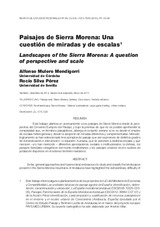Mostrar el registro sencillo del ítem
Paisajes de Sierra Morena: Una cuestión de miradas y de escalas
| dc.contributor.author | Silva Pérez, Rocío | |
| dc.contributor.author | Mulero Mendigorri, Alfonso | |
| dc.date.accessioned | 2016-12-14T11:00:25Z | |
| dc.date.available | 2016-12-14T11:00:25Z | |
| dc.date.issued | 2013 | |
| dc.identifier.uri | http://hdl.handle.net/10396/14172 | |
| dc.description.abstract | Este trabajo plantea un acercamiento a los paisajes de Sierra Morena desde la pers- pectiva del Convenio Europeo del Paisaje, y bajo la premisa de que no es posible aprehender la complejidad que, en términos paisajísticos, alberga el conjunto serrano si no es desde el empleo de escalas heterogéneas y desde la adopción de miradas diferentes y complementarias. Metodo- lógicamente se han seleccionado tres ejemplos de paisaje que son expresivos de distintos grados de domesticación e intervención –o dejación– humana, que se perciben a distintas escalas y que merecen –y/o han merecido – diferentes apreciaciones sociales e institucionales: la dehesa , los paisajes forestales–cinegéticos del monte mediterráneo y los paisajes urbanos de los núcleos de población dispersos en el extenso territorio mariánico. | es_ES |
| dc.description.abstract | So far, general approaches and taxonomical endeavours to study and classify the landscapes present in the Sierra Morena mountains of Andalucía have highlighted the extraordinary diffi culty of such an enterprise. Consequently, the need to unpick as far as possible the diversity of landscapes in the Sierra Morena mountain area as a whole calls for a new approach. Hence, this article proposes to take the perspective of the European Landscape Convention, which is different and comple- mentary to the approaches taken so far. Therefore, the starting premise is that it is not possible to apprehend the complexity which, in terms of landscape, can be found in the Sierra Morena without using heterogeneous scales and adopting different and purposeful perspectives in each case. With this intention, from a methodological point of view, three examples have been chosen of landscapes that express differing degrees of domestication and human intervention – or neglect – which are perceived at different scales and which merit – and/or have merited – different social and institutional valuations: the ‘dehesa’ pastureland, an omnipresent landscape, well recognised and classifi ed, institutionally lauded for its environmental values, and which ultimately is an everyday livestock and agro–forest landscape; the woodland/hunting landscapes of the Mediterranean shrublands, which are more naturalised in appearance and just as vast, the object of contradictory representations of praise for their naturalistic wealth versus recrimination of their serial degradation and hunting uses; and the landscapes of population nuclei which require a more intimate approach owing to their reduced size, looking at an urban scale although not focusing exclusively on the city. Regarding the fi ndings of this paper, the case studies selected demonstrate that the scale used in the approach is critical to analysing and understanding the landscape: the multi–scale perspective allows us to appreciate the typological richness inherent to some basic units of landscape which, owing to the dominant reductive tendency, have been subject to an excessively homogeneous and impoverishing characterisation. This is certainly true of the ‘dehesa’ pasturelands of the Sierra Morena, where their diverse variants have barely been taken into account. Together with the above, using different scales also allows for different spheres of landscape specifi city to be identifi ed which have not been taken into consideration in the typological classifi cations carried out to date, tending to be highly summarised and carried out on a small scale. In general, they do not contemplate the existence of realities which, like the woodland/hunting landscape, have been shaped in relation to specifi c sectors – only perceptible at an intermediate scale – in which very specifi c physiognomic and functional components converge. Finally, looking at this matter in greater depth, only through large– scale approaches can we apprehend the richness of urban landscapes and their ‘ruedos’, whose scant landmass in the Sierra Morena contrasts with their extraordinary qualitative importance. The analysis carried out has, however, highlighted that adequate knowledge of Sierra Morena landscapes cannot be grounded purely in the use of different scales. The three cases analysed show how the inherent complexity of many landscapes requires the adoption of a purposeful and suffi ciently qualifi ed perspective; in other words, one which begins with precise knowledge of the essential processes, both physical–natural and human, which have historically affected each terri- tory. Only then can the different components that converge in each type of landscape be identifi ed, shaping and moulding the character that allows it to be individualised | es_ES |
| dc.format.mimetype | application/pdf | es_ES |
| dc.language.iso | spa | es_ES |
| dc.publisher | Universidades Públicas de Andalucía | es_ES |
| dc.rights | https://creativecommons.org/licenses/by-nc-nd/4.0/ | es_ES |
| dc.source | Revista de Estudios Regionales 96, 35-64 (2013) | es_ES |
| dc.subject | Paisaje rural | es_ES |
| dc.subject | Sierra Morena | es_ES |
| dc.subject | Dehesas | es_ES |
| dc.subject | Caza mayor | es_ES |
| dc.subject | Núcleos urbanos | es_ES |
| dc.subject | Rural landscape | es_ES |
| dc.subject | Large game hunting | es_ES |
| dc.subject | Urban nucleous | es_ES |
| dc.title | Paisajes de Sierra Morena: Una cuestión de miradas y de escalas | es_ES |
| dc.title.alternative | Landscapes of the Sierra Morena: A question of perspective and scale | es_ES |
| dc.type | info:eu-repo/semantics/article | es_ES |
| dc.rights.accessRights | info:eu-repo/semantics/openAccess | es_ES |

